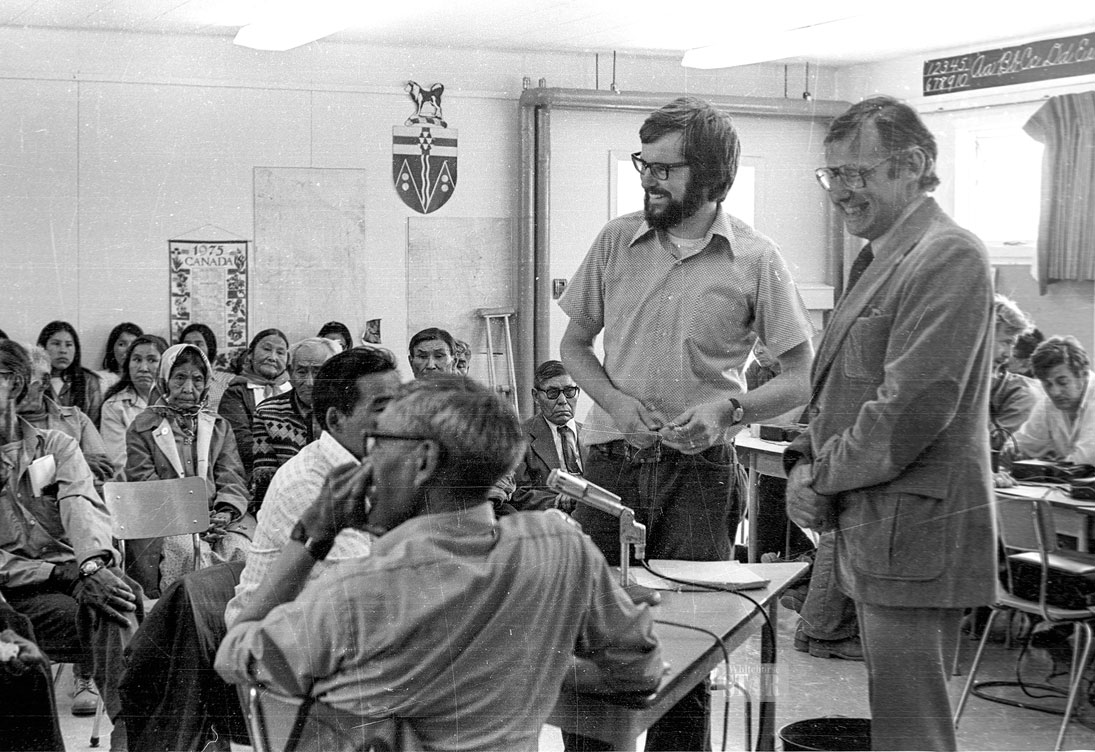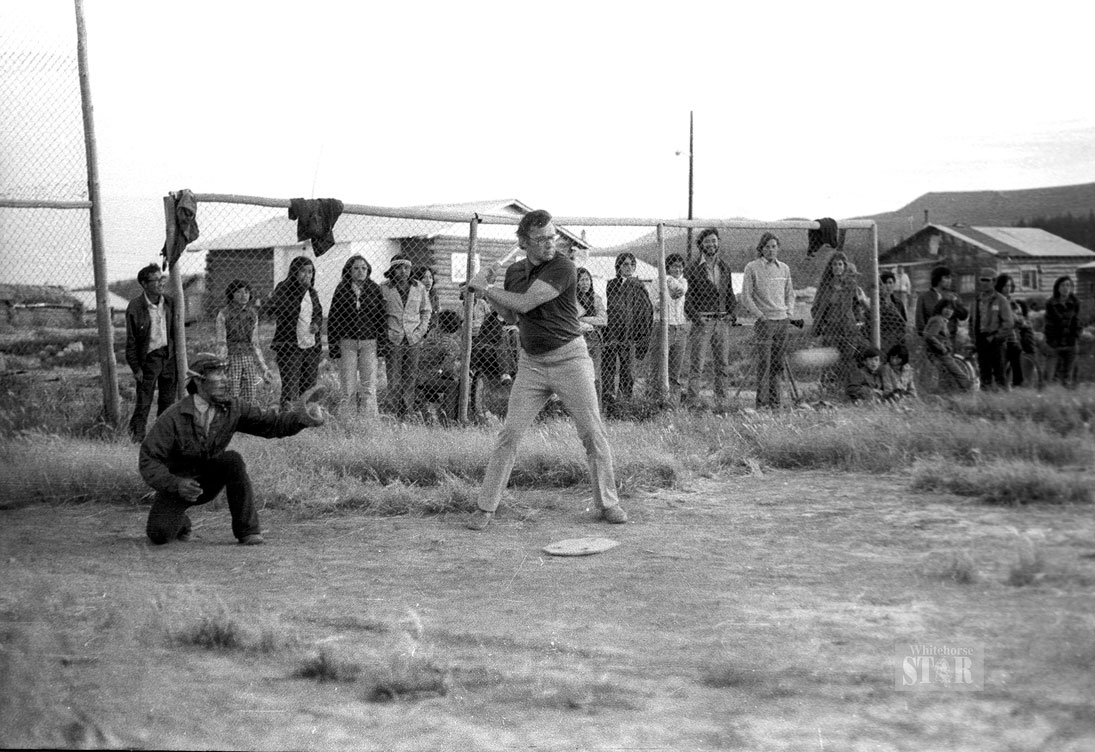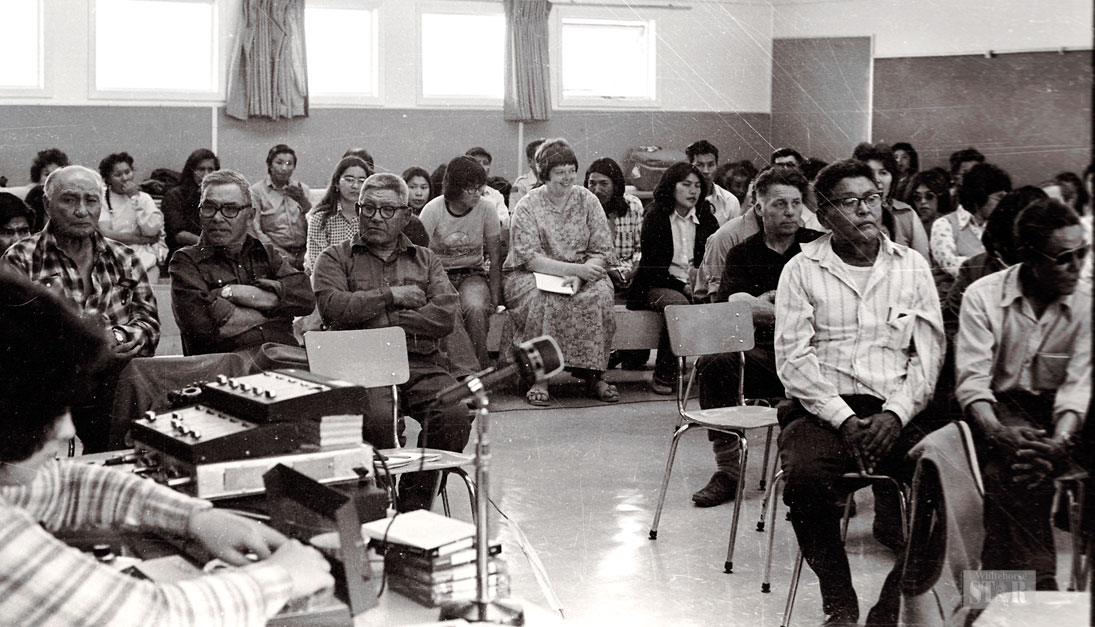Tom Berger, Old Crow and the northern Yukon
The passing of Tom Berger on April 28 at the age of 88 brought back memories for former Star reporter Max Fraser,
By Freelancer on May 21, 2021
The passing of Tom Berger on April 28 at the age of 88 brought back memories for former Star reporter Max Fraser, who covered the Old
Crow community hearings of the Mackenzie Valley Pipeline Inquiry held July 11-14, 1975.
Fraser took a trip down Memory Lane, reviewing his articles and photos from the time and reflecting on events then and since.
Before I first came to the Yukon, I heard about Old Crow. It was almost as famous as the Klondike Gold Rush. Still is.
Hired by the Whitehorse Star in April 1974 at the tender age of 21, I came out of journalism school at Langara in Vancouver and drove my
new-to-me 1968 Oldsmobile Delta 88 Super Rocket with white bucket seats up the potholed Alaska Highway to Whitehorse for my first job as
a reporter-photographer.
At the time, this Vancouver boy barely knew where the Yukon was, but when I asked, everyone mentioned Old Crow and everyone talked
about its world-famous columnist for the Star, Edith Josie.
Edith was a living legend who put Old Crow on the map, thanks to the Star and the syndication of her delightful columns in several big
newspapers Outside.
Old Crow was also famous for top-rated dog mushers who came to Whitehorse for Rendezvous, and cross-country skiers who scored big in
national and international competitions thanks to the coaching of Father Mouchet.
Most of all, it was known then, as it is today, as a community that practised and valued traditional ways, thanks mostly to its isolation.
I got to meet Edith Josie in person my second Yukon summer, in 1975, when the Berger inquiry held hearings in Old Crow.
Going through the pages of the Star at the time, I see we printed a good many articles and photos of these events.
Even Edith, who was known for her brevity, wrote what could have been one of the longest articles of her career about the testimony of
community people to the inquiry.
I remember sitting beside her during the hearings, taking notes and encouraging her to “write lots.”
As in the many small communities along the Mackenzie Valley, the people of Old Crow showed up in big numbers to speak to the inquiry
about their way of life and the negative effects a massive pipeline project would bring.
Berger listened patiently and carefully, often long into the night.
What struck me then – and is still true today – is the sincerity of the beliefs, the unfailing good humour and respectful politeness shown to
one and all.
The community people were good hosts, bringing out the welcome mat for the 30-person fly-in group of translators, lawyers, technicians,
broadcasters and support staff.
One of the most amusing photos from the time is a 2 a.m. baseball game with Berger at bat as the inquiry faced off against the locals. I think
they struck him out, but in a nice way.
There was little in the way of accommodations, and, true to form, the Star considered it entirely appropriate that I pitch a tent for the week I
was there, which I did. I remember it being quite hot beneath the blazing midnight sun.
The hearing drew special attention from Aboriginal and government leaders in Whitehorse, too.
In the photos of people watching the hearings we see Elijah Smith, head of the Council for Yukon Indians (now Council of Yukon First
Nations), sitting beside Carcross-Tagish elder Johnny Johns.
A very youthful Ron Veale, now retired from the Yukon Supreme Court, was counsel for the CYI. I think Smith and Johns were keeping an
eye on him as he was pretty new too.
Important testimony was presented to Berger by archaeologists who were working near the community; they could show evidence of human
occupation of the area dating back up to 30,000 years, as it had not been glaciated during the last Ice Age.
Old Crow people spoke of the importance of Old Crow Flats and the Porcupine caribou herd.
In the end, Berger listened, and ruled out a pipeline along the north coast where the caribou go annually to calve and raise their young.
He also ruled out the secondary route through the Flats within a few miles of Old Crow.
He suggested an alternative route for the natural gas pipeline along the Alaska Highway near Whitehorse, which led to another enquiry
headed by Ken Lysyk.
That pipeline was approved; the right-of-way exists in law today but will never be built.
What Berger also did was put a large environmental stamp on the entire northern Yukon, recommending protection for the north coast as well
as other land north of Old Crow.
In the time since then, between land claim agreements and the creation of parks by the federal and Yukon governments, most of northern
Yukon is protected from industrial development.
Tom Berger had a lot to do with that, and we can honour that part of his memory.
We can also honour the commitment of the Vuntut Gwich’in people of Old Crow to their culture, and persistence by successive generations
of community leaders in the past several decades in advocating for protection of the caribou against industrial interests in the U.S., interests
that regrettably persevere in trying to re-open protected caribou lands on the Alaska side of the border.
In more recent years, Old Crow has emerged as a modern self-governing First Nation with ownership in key Yukon infrastructure, including
Air North.
It has also become famous for tie elections, with decisions in 1996 and 2021 by the drawing of lots.
With a population of about 300 people, every vote counts in a place like Old Crow and every election is close.
Since 1978, Old Crow has had its own seat in the Yukon Legislative Assembly.
Despite its disproportionately small numbers, it remains crucial to the Yukon social and cultural fabric that the community retain its own seat
and voice in Yukon affairs.
By Max Fraser



Comments (4)
Up 7 Down 2
SH on May 25, 2021 at 10:34 am
Good article.
Up 14 Down 3
Dennis Allen on May 24, 2021 at 7:19 am
Thanks Max. Great history.
Up 15 Down 5
Kathleen Theiss on May 22, 2021 at 2:29 pm
That was a loving and respectful article that shared ‘inside/outsider’ history of the precious northern spaces shared by the caribou and Vuntut Gwich’in First Nations inhabitants. Thank you for your heartfelt contribution.
Up 36 Down 13
Sheepchaser on May 21, 2021 at 3:15 pm
Mr Fraser,
Thank you for taking the time to make this happen. Solid illumination and context. Well done indeed.